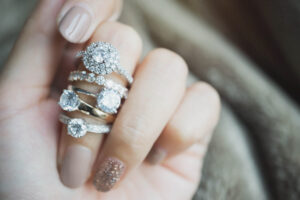
Diamond simulants are now becoming popular as low-cost alternatives to real diamonds. They can offer a look similar to that of diamonds, but their properties are greatly different from real diamonds. Hence, it is important to know the difference between real diamonds and diamond simulants to distinguish them from one another.
Before knowing the difference between real diamonds and diamond stimulants, you have to be aware that lab grown diamonds are not the same as diamond simulants. Lab-created or man-made diamonds are real diamonds that have all the characteristics of natural diamonds. So don’t mistake these stones for diamond simulants.
Signs To Identify Diamond Simulants
The following are some important signs that can help you determine whether a stone is a diamond stimulant.
It Looks Too Clean: Most diamonds come with natural flaws including inclusions and blemishes. Even the most flawless diamonds can have some internal flaws. So if your stones look very clean but come for much cheaper rates, then they can be simulants.
It Retains Heat: Real diamonds have the capability to dissipate heat very quickly. So if you breathe on these stones, they won’t remain foggy.
But diamond simulants do not have this capability. Most of these stones retain heat. You can distinguish between real diamonds and diamond simulants by conducting a fog test. Simply breathe on these stones to find out whether they get foggy. If a layer of fog remains on the surface of the stone, then it is a stimulant.

It Scratches Easily: Diamonds are very hard and extremely durable. They won’t get easily scratched or chipped. But diamond simulants are not as hard as real ones. Most diamond simulants are made of softer substances. Hence, if you find that your stones are getting easily scratched, then it can be a sign that they are stimulants.
It Comes For Cheaper Rates: Diamonds are very costly, especially colorless diamonds with no visible flaws. So if you find colorless and flawless stones for cheaper rates, then they are diamond simulants and not real diamonds.
Its Sparkle Is Very Colorful: Diamonds usually exhibit a white sparkle, but diamond simulants usually showcase all the colors of the rainbow when they sparkle.
There is a wide variety of diamond simulants used in jewelry including moissanite, white sapphire, cubic zirconia, synthetic garnet, spinel, etc. Even though these stones are not as durable as diamonds, they can create a wonderful low-cost alternative for your engagement rings. These stones usually come at very cheaper rates than real diamonds.
